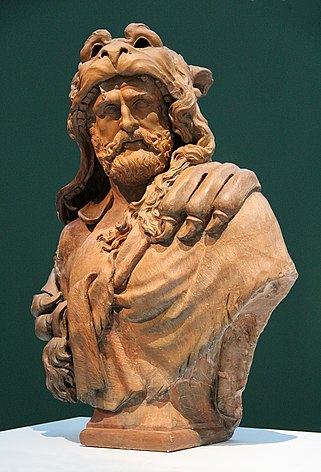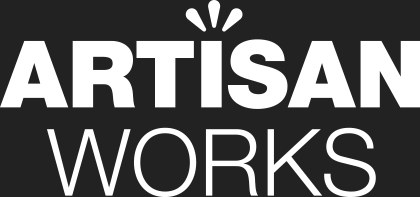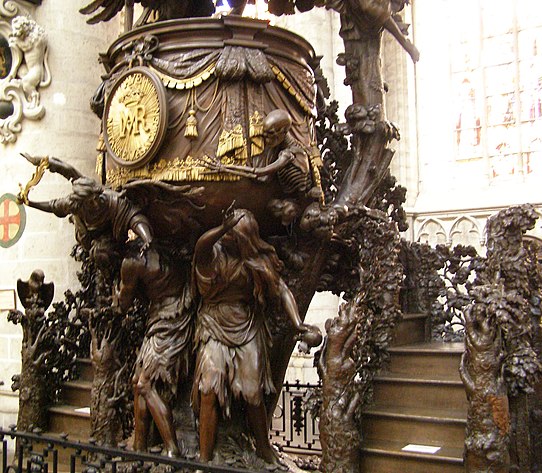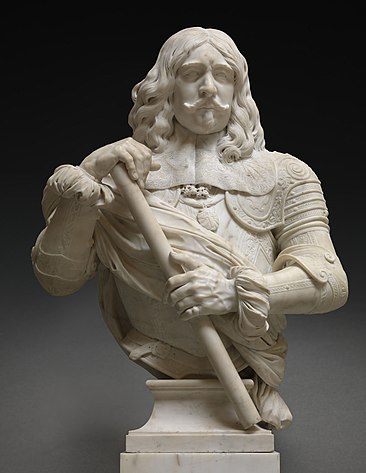The Southern Netherlands, which remained under Spanish, Roman Catholic rule, played an important role in spreading Baroque sculpture in Northern Europe. The Roman Catholic Contrareformation demanded that artists created paintings and sculptures in church contexts that would speak to the illiterate rather than to the well-informed. The Contrareformation stressed certain points of religious doctrine, as a result of which certain church furniture, such as the confessional gained an increased importance. These developments caused a sharp increase in the demand for religious sculpture in the Southern Netherlands.[17] A pivotal role was played by the Brussels sculptor François Duquesnoy who worked for most of his career in Rome. His more elaborate Baroque style closer to that of the Classicism of Bernini was spread in the Southern Netherlands through his brother Jerôme Duquesnoy (II) and other Flemish artists who studied in his workshop in Rome such as Rombaut Pauwels and possibly Artus Quellinus the Elder.[18][19]
The most prominent sculptor was Artus Quellinus the Elder, member of a family of famous sculptors and painters, and the cousin and master of another prominent Flemish sculptor, Artus Quellinus the Younger. Born in Antwerp, he had spent time in Rome where he became familiar with local Baroque sculpture and that of his compatriot François Duquesnoy. On his return to Antwerp in 1640, he brought with him a new vision of the role of the sculptor. The sculptor was no longer to be an ornamentalist but a creator of a total artwork in which architectural components were replaced by sculptures. The church furniture became an occasion for the creation of large-scale compositions, incorporated into the church interior.[4] From 1650 onwards, Quellinus worked for 15 years on the new city hall of Amsterdam together with the lead architect Jacob van Campen. Now called the Royal Palace on the Dam, this construction project, and in particular the marble decorations he and his workshop produced, became an example for other buildings in Amsterdam. The team of sculptors that Artus supervised during his work on the Amsterdam city hall included many sculptors, mainly from Flanders, who would become leading sculptors in their own right such as his cousin Artus Quellinus II, Rombout Verhulst, Bartholomeus Eggers and Gabriël Grupello and probably also Grinling Gibbons. They would later spread his Baroque idiom in the Dutch Republic, Germany and England.[20][21] Another important Flemish Baroque sculptor was Lucas Faydherbe (1617-1697) who was from Mechelen, the second important centre of Baroque sculpture in the Southern Netherlands. He trained in Antwerp in Rubens’s workshop and played a major role in the spread of High Baroque sculpture in the Southern Netherlands.[22]
While the Southern Netherlands had witnessed as steep decline in the level of the output and reputation of its painting school in the second half of the 17th century, sculpture replaced painting in importance, under the impulse of domestic and international demand and the massive, high-quality output of a number of family workshops in Antwerp. In particular, the workshops of Quellinus, Jan and Robrecht Colyn de Nole, Jan and Cornelis van Mildert, Hubrecht and Norbert van den Eynde, Peter I, Peter II and Hendrik Frans Verbrugghen, Willem and Willem Ignatius Kerricx, Pieter Scheemaeckers and Lodewijk Willemsens produced a wide range of sculpture including church furniture, funeral monuments and small-scale sculpture executed in ivory and durable woods such as boxwood.[17] While Artus Quellinus the Elder represented the high Baroque, a more exuberant phase of the Baroque referred to as late Baroque commenced from the 1660s. During this phase the works became more theatrical, manifested through religious-ecstatic representations and lavish, showy decorations。

Post time: Aug-16-2022


